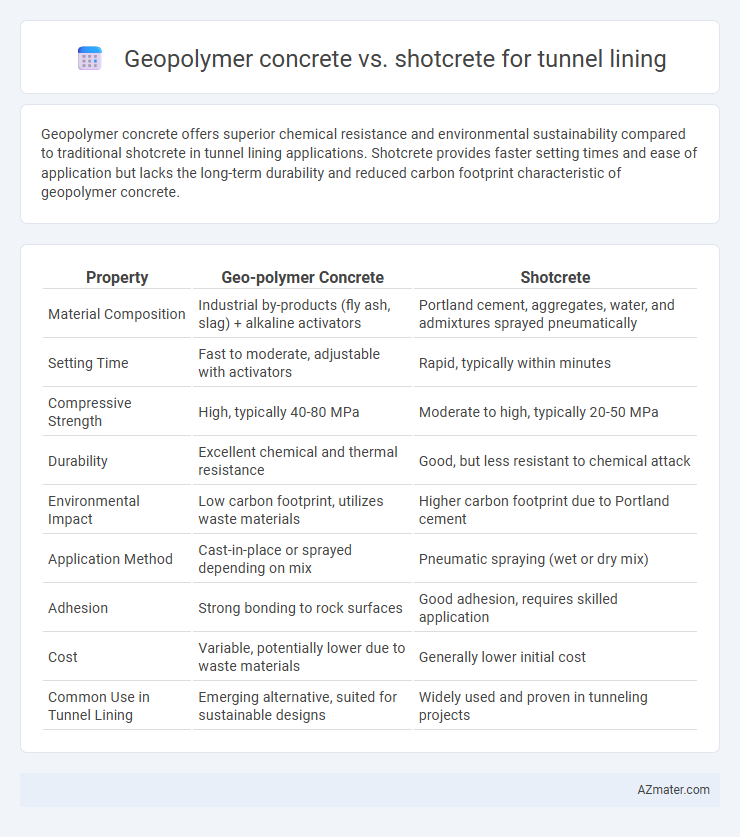Geopolymer concrete offers superior chemical resistance and environmental sustainability compared to traditional shotcrete in tunnel lining applications. Shotcrete provides faster setting times and ease of application but lacks the long-term durability and reduced carbon footprint characteristic of geopolymer concrete.
Table of Comparison
| Property | Geo-polymer Concrete | Shotcrete |
|---|---|---|
| Material Composition | Industrial by-products (fly ash, slag) + alkaline activators | Portland cement, aggregates, water, and admixtures sprayed pneumatically |
| Setting Time | Fast to moderate, adjustable with activators | Rapid, typically within minutes |
| Compressive Strength | High, typically 40-80 MPa | Moderate to high, typically 20-50 MPa |
| Durability | Excellent chemical and thermal resistance | Good, but less resistant to chemical attack |
| Environmental Impact | Low carbon footprint, utilizes waste materials | Higher carbon footprint due to Portland cement |
| Application Method | Cast-in-place or sprayed depending on mix | Pneumatic spraying (wet or dry mix) |
| Adhesion | Strong bonding to rock surfaces | Good adhesion, requires skilled application |
| Cost | Variable, potentially lower due to waste materials | Generally lower initial cost |
| Common Use in Tunnel Lining | Emerging alternative, suited for sustainable designs | Widely used and proven in tunneling projects |
Introduction to Tunnel Lining Materials
Geo-polymer concrete offers enhanced durability and chemical resistance compared to traditional Shotcrete, making it ideal for aggressive tunnel environments. Shotcrete remains widely used due to its ease of application and rapid setting time, especially in complex tunnel geometries. Selecting between Geo-polymer concrete and Shotcrete depends on factors such as structural requirements, environmental exposure, and maintenance considerations in tunnel lining projects.
Overview of Geo-polymer Concrete
Geo-polymer concrete is an innovative construction material composed of industrial waste such as fly ash and slag, activated by alkaline solutions to form a durable binder with low carbon emissions. Its superior chemical resistance and high early strength make it suitable for tunnel lining applications where durability and sustainability are critical. The reduced environmental footprint compared to traditional Portland cement-based shotcrete positions geo-polymer concrete as a promising alternative in underground construction projects.
Understanding Shotcrete for Tunnel Applications
Shotcrete is a sprayed concrete mix widely used in tunnel lining for its rapid application and excellent adhesion to irregular surfaces, offering immediate structural support. It consists of cement, aggregates, water, and additives, applied pneumatically to conform closely to the tunnel profile, reducing formwork needs. Compared to geopolymer concrete, shotcrete provides faster setting times and ease of application in confined spaces, although geopolymer options offer benefits in durability and environmental impact.
Material Properties Comparison
Geopolymer concrete exhibits superior chemical resistance, high thermal stability, and enhanced durability compared to conventional shotcrete, making it ideal for aggressive tunnel environments. Shotcrete offers rapid application and excellent initial adhesion, but its material properties, such as lower compressive strength and susceptibility to rebound, may limit long-term performance. The alkali-activated binders in geopolymer concrete contribute to reduced shrinkage and higher fire resistance, while shotcrete relies on cementitious mixtures prone to carbonation and chloride ingress.
Environmental Impact and Sustainability
Geo-polymer concrete significantly reduces carbon emissions compared to traditional shotcrete by utilizing industrial by-products like fly ash and slag, lowering the reliance on Portland cement. This eco-friendly alternative offers enhanced durability and chemical resistance, which extends tunnel lining lifespan and reduces maintenance waste. Shotcrete, although versatile and quick to apply, generally has a higher environmental footprint due to cement content and frequent repairs, making geo-polymer concrete a more sustainable choice for tunnel infrastructure.
Structural Performance and Durability
Geo-polymer concrete exhibits superior chemical resistance and higher compressive strength compared to traditional shotcrete, making it ideal for tunnel lining in aggressive environments. Its low shrinkage and enhanced durability contribute to prolonged service life and reduced maintenance costs. Shotcrete offers rapid application and excellent adhesion, but may show inferior long-term durability and susceptibility to cracking under complex load conditions.
Installation Methods and Speed
Geo-polymer concrete for tunnel lining offers rapid installation due to its superior workability and faster setting times compared to traditional materials. Shotcrete, applied through pneumatic spraying, enables quick lining with excellent conformity to complex tunnel geometries, often reducing formwork requirements. Installation speed for geo-polymer concrete improves overall project timelines by minimizing curing periods, while shotcrete accelerates application but may require additional finishing steps for optimal surface quality.
Cost Analysis and Economic Considerations
Geo-polymer concrete reduces life-cycle costs in tunnel lining through lower raw material expenses and diminished carbon footprint penalties compared to traditional shotcrete. Shotcrete exhibits faster initial application and curing times, decreasing labor costs but often requires frequent maintenance due to lower durability. Economic considerations favor geo-polymer concrete for long-term infrastructure projects where sustainability and reduced repair costs offset higher upfront material expenses.
Case Studies in Tunnel Lining Projects
Geo-polymer concrete demonstrates superior durability and chemical resistance in tunnel lining projects, as shown by case studies in urban metro systems where it significantly reduced maintenance costs. Shotcrete remains widely used due to its rapid application and structural conformity, with numerous tunnel projects in mountainous terrains validating its efficiency for immediate support. Comparative analysis from case studies reveals geo-polymer concrete's environmental benefits and long-term performance enhancements, while shotcrete excels in speed and adaptability during excavation phases.
Recommendations and Future Trends
Geo-polymer concrete offers superior chemical resistance and environmental benefits compared to traditional shotcrete, making it ideal for sustainable tunnel lining in corrosive environments. Future trends emphasize enhancing the durability and rapid-setting properties of geo-polymer materials through nano-additives and advanced curing techniques, increasing their applicability in complex tunnel geometries. Recommendations include integrating real-time monitoring systems with shotcrete and geo-polymer applications to optimize performance and ensure structural safety in underground constructions.

Infographic: Geo-polymer concrete vs Shotcrete for Tunnel lining
 azmater.com
azmater.com